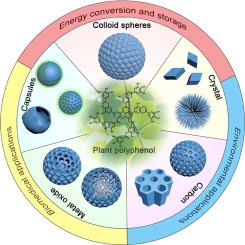Coordination Chemistry Reviews ( IF 20.6 ) Pub Date : 2022-06-09 , DOI: 10.1016/j.ccr.2022.214649 Youyou Feng, Ping Li, Jing Wei

|
The conversion of metal–organic hybrids (e.g., metal–organic frameworks) into functional nanoporous materials has attracted intensive attention because nanoporous materials show tailorable compositions and nanoarchitectures, as well as broad potential applications in energy, environment, sensor and biomedicine. Plant polyphenols, as ubiquitous biomass, reveal low cost, nontoxicity, strong metal chelate ability and good adhesive property towards various substrates. Plant polyphenols and their coordination polymers have recently been regarded as a powerful tool for engineering functional nanomaterials. Herein, the recent progress of plant polyphenol-based coordination polymers and their derived functional mesoporous materials have been comprehensively reviewed. Firstly, based on the strong interactions between polyphenols and various assembly units (e.g., metal ions, soft-template) or substrates (e.g., polystyrene sphere), metal-polyphenol coordination polymers (MPCPs) with capsule structure, crystalline framework, colloidal spheres or mesoporous network can be prepared. Secondly, polyphenols are regarded as an excellent sustainable carbon source. When metal-polyphenol coordination polymers are used as a carbon precursor, mesoporous carbon materials including pure carbon, heteroatom doping, or metal nanoparticle loading are prepared. Thirdly, due to the tunable compositions of MPCPs, mesoporous metal oxide spheres with tunable metal species, solid or hollow structure, complex compositions (e.g., multi-metals or high-entropy metal oxides) are prepared. Fourthly, the applications of MPCPs derived mesoporous materials, including energy conversion and storage, environmental remediation and biomedicine, have been summarized. Compared with the most commonly used metal–organic frameworks, MPCPs are constructed from renewable plant polyphenols. Most importantly, polyphenols are one kind molecular glue and can interact with various molecules. Various components can be incorporated into the MPCPs. MPCPs can also be deposited on various substrates. After thermal decomposition, functional nanoporous composites and films are obtained. We believe this review will bride the polyphenol chemistry with nanoporous materials and promote the creation of more functional porous materials from polyphenols.
中文翻译:

基于植物多酚的配位聚合物工程功能性介孔材料
金属-有机杂化物的转化(例如, 金属有机框架) 转化为功能性纳米多孔材料引起了广泛关注,因为纳米多孔材料具有可定制的组成和纳米结构,以及在能源、环境、传感器和生物医学方面的广泛潜在应用。植物多酚作为普遍存在的生物质,具有成本低、无毒、金属螯合能力强、对各种基材具有良好的粘附性等优点。植物多酚及其配位聚合物最近被认为是工程功能纳米材料的有力工具。本文对植物多酚基配位聚合物及其衍生的功能性介孔材料的最新进展进行了全面综述。首先,基于多酚与各种组装单元之间的强相互作用(例如、金属离子、软模板)或底物(例如聚苯乙烯球)、具有胶囊结构、结晶框架、胶体球或介孔网络的金属-多酚配位聚合物(MPCP)。其次,多酚被认为是一种极好的可持续碳源。当金属-多酚配位聚合物用作碳前体时,制备了包括纯碳、杂原子掺杂或金属纳米颗粒负载的介孔碳材料。第三,由于 MPCPs 的成分可调,介孔金属氧化物球具有可调金属种类,实心或空心结构,复杂的成分(例如,多金属或高熵金属氧化物)制备。第四,总结了MPCPs衍生介孔材料在能量转换与存储、环境修复和生物医学等方面的应用。与最常用的金属有机骨架相比,MPCPs 由可再生植物多酚构成。最重要的是,多酚是一种分子胶,可以与各种分子相互作用。可以将各种组件合并到 MPCP 中。MPCP 也可以沉积在各种基材上。热分解后,得到功能性纳米多孔复合材料和薄膜。我们相信,这篇综述将使多酚化学与纳米多孔材料相结合,并促进从多酚中创造出更多功能的多孔材料。


























 京公网安备 11010802027423号
京公网安备 11010802027423号